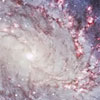CXC Home | Search | Help | Image Use Policy | Latest Images | Privacy | Accessibility | Glossary | Q&A
Tour of SN 1957D in M83
Quicktime MPEG
Over fifty years ago, a supernova was discovered in M83, a spiral galaxy about 15 million light years from Earth. This supernova was dubbed SN 1957D because it was the fourth one detected in the year of 1957. Since then, astronomers have tried to detect the remains of SN 1957D in different wavelengths. They successfully spotted it in radio waves in 1981, and then in optical light in 1987. Previous attempts with X-ray telescopes, however, did not reveal anything. A new long from Chandra of the spiral galaxy where this object was found --totaling about 8 and half days of observing time - finally did. Chandra's new X-ray data from the remnant of SN 1957D provide important information about the nature of this explosion that astronomers think happened when a massive star ran out of fuel and collapsed over half a century ago. The Chandra data suggest a rapidly rotating neutron star was formed by the explosion, which would be one of the youngest objects of this type ever observed.
[Runtime: 01:13]
Quicktime MPEG
Over fifty years ago, a supernova was discovered in M83, a spiral galaxy about 15 million light years from Earth. This supernova was dubbed SN 1957D because it was the fourth one detected in the year of 1957. Since then, astronomers have tried to detect the remains of SN 1957D in different wavelengths. They successfully spotted it in radio waves in 1981, and then in optical light in 1987. Previous attempts with X-ray telescopes, however, did not reveal anything. A new long from Chandra of the spiral galaxy where this object was found --totaling about 8 and half days of observing time - finally did. Chandra's new X-ray data from the remnant of SN 1957D provide important information about the nature of this explosion that astronomers think happened when a massive star ran out of fuel and collapsed over half a century ago. The Chandra data suggest a rapidly rotating neutron star was formed by the explosion, which would be one of the youngest objects of this type ever observed.
[Runtime: 01:13]
(Credit: NASA/CXC/A. Hobart)
Return to SN 1957D in M83 (July 30, 2012)



